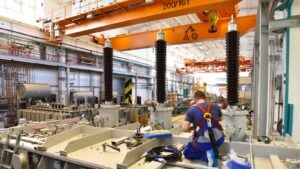Canada is giving Arianne Phosphate up to C$735,000 to help process phosphorus from its Lac à Paul deposit in Quebec. This money will go to the upstream links of its battery ecosystem.
The award comes from the Critical Minerals Research, Development, and Demonstration program. It is part of a larger C$80.3 million package that was announced at the G7 Leaders’ Summit to strengthen the country’s supply chains for critical minerals.
The government said that if the project were to be commercialized, it could make purified phosphoric acid for lithium iron phosphate batteries in the US and also help with fertilizer and specialty products. Natural Resources Canada gave details about the investment in a news release.
The announcement, which was made in Saguenay, is about engineering steps that are important for manufacturing.
Arianne wants to improve the processing of phosphate rock and make the purification process as efficient as possible.
This is the stage that decides if phosphorus can meet battery-grade standards at a large scale and low cost.
That focus shows a change in industrial policy from just getting minerals out of the ground to showing off midstream capabilities in Canada, where most of the value and risk are.
Ottawa put the money in the context of a longer story. Of the G7 package, C$50.3 million is set aside for research and development (R&D) and technology demonstrations in Canada.
These are meant to close processing gaps and level the playing field against market disruptions that are planned.
That focus is in line with the federal Critical Minerals Strategy and with efforts to connect Canadian projects to supply chains in other countries instead of relying on just one buyer or jurisdiction.
Officials also said that the Arianne funding was a sign to private investors. In a government release, Tim Hodgson, the Minister of Energy and Natural Resources, said, “We are strengthening Canada’s leadership in critical minerals.”
In the same release, Marco Gagnon, executive chairman of Arianne Phosphate, said that the federal support “lets us move forward the development of our Lac à Paul project.”
Even though the amount for Arianne is small, conditional awards like this can lower technical risk and make it easier to get more money for bigger pilot and commercial phases. The rules and laws about batteries are changing quickly.
Over the past two years, Ottawa has spent billions on deals to make cell phones and put together cars, while also changing the timelines and trade-offs.
This year, Prime Minister Mark Carney put the EV mandate on hold to find a balance between jobs, tariffs, and pressures from other countries. This was even though planners were talking about what Canada’s new mega battery plant could mean for the industry.
The Arianne decision shows that cell and vehicle factories also need reliable inputs from within the country, especially for chemistries like LFP that need high-purity phosphoric acid.
Quebec is at the heart of that vision. The province has hydropower, access to the St. Lawrence River, and a number of metals projects at different stages of development. The federal government has not only looked at battery cathodes and anodes.
Ottawa has made copper a key part of its plans to upgrade the grid and make it more electrified. This is a topic we talked about in our recent coverage of what Ottawa sees in copper.
Consolidation among Canadian miners has also kept base metals in the news in capital markets. For example, the Teck and Anglo merger shows how a few companies can control a lot of supply and processing capacity.
Phosphate isn’t a flashy metal, but how it’s processed is very important for how cost-effective LFP-based storage and mass-market EVs are.
Conditional grants from programs like CMRDD help make the technology pathway from lab to pilot less risky. This can speed up the time it takes to get offtake agreements and project financing.
The amounts are smaller than the headline factory subsidies, but they focus on the problems that have stopped projects all over North America. The plan from the federal government is still going ahead.
Ottawa has chosen the first projects for Canada’s Major Projects Office to speed up the permitting process for important national buildings. It has also put critical minerals research and development as a way to support those efforts.
The Arianne decision will be judged on how well it is carried out, such as whether the process consistently meets battery-grade purity and whether the company can find long-term buyers.
If that happens, Quebec could add another link to a battery chain that is starting to go from mine to module.




















